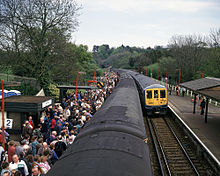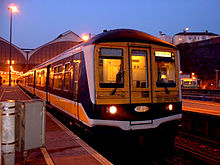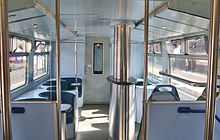- British Rail Class 319
-
British Rail Class 319
First Capital Connect refreshed Class 319/3 EMUs No. 319369 and 319368 at St. Albans
The refreshed interior of a Class 319/3 EMUIn service 1987 - Current Manufacturer BREL York Family name BR Second Generation (Mark 3) Constructed 1987 - 1988, 1990 Number built 86 trainsets Formation 4 cars per trainset Operator First Capital Connect Line(s) served Thameslink Specifications Maximum speed 100 mph (161 km/h) Electric system(s) 25 kV AC Overhead lines
750 V DC 3rd railGauge 1,435 mm (4 ft 8 1⁄2 in) Standard gauge The British Rail Class 319 dual-voltage electric multiple units (EMU) were built by BREL York in two batches in 1987–88 and 1990. The trains were introduced for new north-south cross-London services from Bedford to Brighton, and since privatisation these services have been operated by Thameslink and First Capital Connect, the former franchise having been merged with the Great Northern section of the former WAGN franchise to form the latter train operating company on 1 April 2006 as a result of re-franchising. Class 319 units have dual-power pick-up, from either 25 kV alternating current (AC) overhead lines for services north of London, or 750 V direct current (DC) third rail to the south. However, some units were used only on outer suburban services in South London. The Class 325 postal units were based on the Class 319 units, with the same traction equipment and body design, but are fitted with cabs of the same design as the newer Class 365 and Class 465 Networker units.
Contents
Description
In the 1980s, there were plans for a rail service that would link Bedford and Brighton. These services would cross London in a north-south direction, and thus became the first route for many years to cross London from north to south. These services were branded Thameslink by Network SouthEast, which operated the services.
Before the Thameslink service became operational in 1988, stations along the Midland Main Line north of London were served by Class 317 electric multiple units, introduced in 1981. This required the electrification (using 25 kV AC overhead wires) of the line between Bedford and London St. Pancras and the branch to Moorgate. This service was therefore known colloquially as the "Bed-Pan" service. Key destinations included Bedford, Luton, St Albans, Moorgate, and London St. Pancras.
As the Thameslink service was to use a route with 25 kV AC OHLE north of Farringdon and along the branch to Moorgate, and 750 V DC third-rail electrification south of Farringdon, the Class 319 trains were built with dual-voltage capabilities, making them very versatile.[1] Their body shape is slightly different from contemporary electric units due to restrictions in the loading gauge in Kings Cross tunnel, which meant that other dual-voltage units were not suitable.[citation needed] They were also required to have Emergency end doors in the cabs,[2] due to the twin single bore layout of Smithfield tunnel preventing normal train evacuation.
Two sub-classes of Class 319 units were originally built. Over the years, units have been refurbished, creating five sub-classes, of which four still exist.
Class 319/0
The first batch of 60 units, built in 1987–88, were classified as Class 319/0. Units were numbered in the range 319001–060 and had a maximum speed of 100 mph. Each unit consisted of four carriages; two outer driving trailers, an intermediate motor with a roof mounted Stone Faiveley AMBR pantograph and four DC GEC G315BZ traction motors (two per a bogie), and an intermediate trailer housing a compressor, motor alternator and two toilets. Seating was standard class only, in 2+3 layout. The technical description of the unit formation is DTSO(A)+MSO+TSO+DTSO(B). Individual vehicles were numbered as follows:
- 77291–77381 (odd) and 77431–77457 (odd) — DTSO(A)
- 62891–62936 and 62961–62974 — MSO
- 71772–71817 and 71866–71879 — TSO
- 77290–77380 (even) and 77430–77456 (even) — DTSO(B)
DTSO(B) was configured with a lockable sliding door in the section between the driving cab and the first set of power doors, and the longitudinal bench seats there were hinged to tip up. This was to enable the units to carry parcels if required, but was rarely used. The sliding door is being removed during unit refurbishment, but the tip up seat area has been retained for carrying bicycles and wheelchairs.
Vehicles were numbered in two ranges, corresponding to units 319001–046 and 319047–060. The gaps in the number series (e.g. 77382–77429) were filled by the Class 442 units, which were being built around the same period.
These units were built for long-distance cross-London services between Bedford and Brighton, using the Midland Main Line between Bedford and London, and the Brighton Main Line between London and Brighton. This service crosses London by means of the reopened Snow Hill tunnel between Farringdon and London Blackfriars. When new, the units were painted in Network SouthEast livery. Once the subclass 319/1 batch were built, these trains were then to be found working local inner-suburban services between Luton - St. Albans - London - Sutton/Wimbledon.
When privatisation came, the first 13 units (319001–319013) were used for outer-suburban services by Connex South Central, some losing their 25 kV AC overhead equipment, although it has since has been refitted. 319014–319020 were rebuilt into 319214–319220; see Class 319/2 below for details.
Thameslink
Those numbered in the 319021-319060 series were retained by Thameslink, who had them refurbished at Railcare Wolverton in 1997-8. The interior refurbishment featured the following:
- Installation of blue carpets
- Installation of first-class compartment in DTSO (A), the vehicle next to the MSO[3]
- Retrimmed seats into the blue/yellow Thameslink moquette[3] - some seats were removed in the centre of each vehicle to give a 2+2 layout
The exteriors were reliveried into the Thameslink navy blue bodyside with yellow and white stripes livery. They were renumbered into the subclass 319/4, in the range of 319421-319460, by adding four hundred to each unit number. The sub-class 319/4 units were then moved on to the Bedford - Luton - St. Albans - London - East Croydon - Gatwick Airport - Brighton service, known as 'THAMESLINK Cityflier'.
In the period 2003-5, during the Thameslink blockade, some of the sub-class 319/4s were given a minor interior refresh with retrimmed seats in a modified version of the Thameslink moquette. All sub-class 319/4 units received a refurbished First Class compartment, apart from 319444, which retained its original 1997-designed first-class compartment. The first-class compartments were enhanced by the following improvements:
- New carpet trim
- Chrome-plated heater panels
- Retrimmed seats in a new version of Thameslink moquette
Class 319/1
The second batch of 26 units, built in 1990, were classified Class 319/1.[1] Units were numbered in the range 319161–186. The formation of the second batch of sets was similar to that of the earlier units, except there was provision for first-class seating in Driving Trailer (A) and the MSO vehicle was fitted with the roof-mounted, more modern Brecknell Willis High Speed pantograph design. Like the first batch, seating was 2+3 layout in standard class, with 2+2 seating in first class. Thus, each unit was formed DTCO+MSO+TSO+DTSO. Individual vehicles were numbered as follows:
- 77459–77497 (odd) and 77973–77983 (odd) — DTCO
- 63043–63062 and 63093–63098 — MSO
- 71929–71948 and 71979-71984 — TSO
- 77458–77496 (even) and 77972–77984 (even) — DTSO
Vehicles were numbered in two ranges, corresponding to units 319161–180 and 319181–186.
The second batch were first used for Bedford - Luton - St. Albans - London - East Croydon - Gatwick Airport - Brighton due to them having first-class accommodation aboard the DTCO vehicle.[1]
Thameslink
In the period 1997-9[3], Thameslink ordered the sub-class 319/1 units to be converted at Eastleigh for use on Luton - St. Albans - London - Sutton/Wimbledon service, known as 'THAMESLINK CityMetro'. The conversion involved removing first-class compartments from the DTCO vehicles (thus changing them to DTSO), a relivery into Thameslink navy-blue bodyside with yellow and white stripes livery, and renumbering into the subclass 319/3. In the period 2003-5, during the Thameslink blockade, all of the sub-class 319/3s were given a minor interior refresh with retrimmed seats in a modified version of the Thameslink moquette.
Current operations
Following privatisation of British Rail, the Class 319 fleet was divided between two operators. Thameslink inherited the majority of the fleet, with units 319021–060 and 319161–186. Connex South Central inherited a small fleet of twenty units, nos. 319001–020. Connex was later stripped of its franchise, which was then re-allocated to Govia and subsequently renamed South Central and thereafter Southern, whereas Thameslink (which was itself a Govia franchise until April 2006) has become part of First Capital Connect.
First Capital Connect
First Capital Connect refreshed Class 319/0 No. 319003 departs London St. Pancras, with a service bound for Bedford
First Capital Connect took over the Thameslink franchise on 1 April 2006. It gradually applied its livery in the form of vinyl to the exterior of many trains.
On 26 October 2006, the first fully refreshed train was launched. This was subclass 319/4 unit No. 319425 and was named Transforming Travel on its press launch trip from Bedford to Brighton. During the trip, the refreshed train was displayed to rail user groups as well as the media.
The First Capital Connect subclass 319/4 refresh featured the following improvements:
- Emergency brake pressure increased to the +12% G standard, giving an extra 1 Bar brake cylinder pressure in emergency
- Emergency brake 'timeout' period reduced from 2 minutes to 20 seconds
- DC traction motors rewound to improve reliability
- Improved motor control hardware with a new Remote Communications Frame
- New 'easy to clean' flooring
- Retrimmed seats into the First Capital Connect moquette
- Some seats in standard class were removed and vertical luggage stacks installed in their place; a further two seats were removed in the TSO vehicle to allow easier access to the toilet
- Repainted daldo side panels and wall ends
- Existing stanchions painted pink
- New stanchions leading from some seats to the overhead luggage rack to provide standing passengers with something to hold on to and more support
- Improved, brighter fluorescent lighting diffusers
The refresh took place at Railcare Wolverton works and also featured both a mechanical overhaul (under the solebar) and a full exterior relivery, again in vinyl. Some Class 319/4 units have had their Stone Faiveley AMBR air and spring pantograph replaced by the more modern Bracknell Willis High Speed air-only pantograph design.
Apart from around 12 subclass 319/4 members, the majority of the subclass have been externally reliveried and internally refreshed. The company is now relivering and refreshing the subclass 319/3 fleet, to the same specification as subclass 319/4; however these units remain Standard Class only, with the 2+3 seating arrangement throughout, and do not feature vertical luggage stacks. The last Class 319/3 was outshopped from Railcare, Wolverton following refresh at the end of March 2010.
As mentioned above, First Capital Connect is sub-leasing 8 Class 319/0 units from Southern. As part of the Route Utilisation Strategy for the Brighton Main Line, 48 Class 319 coaches have been transferred to First Capital Connect from Southern.[4]
First Capital Connect have leased all Southern's Class 319s and have stated it will be a permanent move meaning they will not return to Southern. The remaining 319/0s will be refreshed during the course of 2010 and 319/2s will receive an exterior relivery and interior refresh, including the replacement of the snug area underneath the pantograph aboard the PMSO vehicle with 16 proper seats from March 2010. The Class 319/2s worked with Thameslink in a short period but were transferred back to Southern following First Capital Connect taking over the Thameslink franchise.
Southeastern
Southeastern jointly operates the 319s with First Capital Connect on its Sevenoaks to Kentish Town / Bedford services. This is because the London Blackfriars terminal platforms have been closed for the Thameslink Programme. Under this arrangement trains are classified as an FCC service whilst north of Blackfriars, and a Southeastern service whilst south of there. The work is split between FCC drivers from Bedford and Blackfriars, and Southeastern drivers from Victoria and Orpington depots. All of those drivers sign the whole route from Sevenoaks to Bedford. Thus with the cascaded stock it is currently possible to find a Southern liveried 319 operating an FCC service whilst being driven by a Southeastern driver.
Former operations
Southern
Seven of the Class 319/0 sets (319014–319020) were rebuilt into Class 319/2 units (319214–319220) and dedicated to Brighton Express services from London Victoria to Brighton.[3] (Class 377 "Electrostar" and Class 442 "Wessex Electric" units now operate all of these services). These units were rebuilt by Railcare Wolverton to give them low-density interiors, a disabled toilet, and a special 'lounge' seating area in the saloon space below the pantograph in the MSO, where a buffet counter was provided.
When Class 377/3 units replaced them on Brighton Express services, the seven Class 319/2 units were allocated to peak-only London-Guildford via West Croydon and London-Horsham via Three Bridges services.
As part of a long-term loan agreement, Southern currently subleases all of its Class 319/0 units to First Capital Connect, as well as the Class 319/2 units which followed when Class 377 trains replaced them. Thus the entire Class 319 fleet is now operating FCC Thameslink services.
Future plans
As part of its announcement of the electrification of both the Great Western Main Line and the Liverpool to Manchester (via Newton Le Willows) route, the Government has announced that when new Thameslink rolling stock arrives from 2015-2018.[5] Class 319s will be refurbished, fitted with air-conditioning, and transferred to the following two routes:
- to operate all suburban services between Oxford, Newbury, Reading and London
- to operate Manchester Airport to Liverpool Lime Street and Manchester Victoria to Liverpool Lime Street services[6]
Notable units
 319008 operating "Tunnel Explorer" excursions into the Channel Tunnel on 7 May 1994 from Sandling railway station; the first public-carrying passenger trains through the tunnel
319008 operating "Tunnel Explorer" excursions into the Channel Tunnel on 7 May 1994 from Sandling railway station; the first public-carrying passenger trains through the tunnel
Units 319008 and 319009 are notable for two reasons:
- On 10 December 1993 they travelled through the Channel Tunnel to Calais-Fréthun and back with a party of invited guests, after the construction consortium TransManche Link (who were responsible for the construction of the Tunnel) had transferred responsibility for operations and management over to Eurotunnel. Their pantographs were modified at Chart Leacon depot in Ashford beforehand. For the subsequent "Folkestone 1994" event on 5 May 1993, which saw the first paying members of the public taken into the tunnel by train, units 319008 and 319009 were named "Cheriton" and "Coquelles" respectively, and plaques adorned with the Union Flag and Tricolor were installed on their motor carriages.[7][3]
- In 1994 they set a record for the shortest London to Brighton journey time, at 37 minutes 54 seconds. This was improved upon in 2005, with the Speed Run event by Southern, using its Class 377 units 377472 and 377474. The new record is 36 minutes 56 seconds.[8]
Both units have been denamed since being transferred from Southern to First Capital Connect.
Gallery
-
Southern liveried Class 319/0 No. 319011 at London St. Pancras, working a First Capital Connect service, bound for Brighton
-
A refurbished Southern Class 319/2 No. 319219 at Bedford, working a First Capital Connect service, bound for Brighton
-
First Capital Connect refreshed Class 319/4 EMU No. 319456 at London St. Pancras, with a service bound for Brighton
-
One of the pair of ‘Thameslink Programme’ advertising liveried Class 319/3 EMUs, No. 319364 ‘Transforming Blackfriars at St. Albans City, with a service bound for the Streatham - Sutton/Wimbledon loop
-
The other Class 319/3 EMU in the ‘Thameslink Programme’ advertising livery is 319365 ‘Transforming Farringdon’ and is seen at London St. Pancras.
-
A Connex South Central class 319 EMU rips trough Bletchley station in 2000. It is operating a service from Gatwick Airport to Rugby.
Fleet details
Class Operator No. Built Year Built Cars per Set Unit nos. Notes Class 319/0 First Capital Connect 13 1987–1988 4 319001 - 319013 Class 319/2 7 319214 - 319220 Refurbished from Class 319/0 1996-1997.
Originally classed as 319/0. (319014 - 319020)Class 319/3 26 1990 319361 - 319386 Refurbished from Class 319/1 1997-1999.
Originally classed as 319/1. (319161 - 319186)Class 319/4 40 1987–1988 319421 - 319460 Refurbished from Class 319/0 1997-1998.
Originally classed as 319/0. (319021 - 319060)References
- ^ a b c Class 319 - Welcome to the Southern E-Group Web Site. Retrieved 2011-03-20.
- ^ Thameslink - Moorgate Branch: Local instructions/Working over book (July 1999)
- ^ a b c d e Class 319 2 Page. - Welcome to the Southern E-Group Web Site. Retrieved 2011-03-20.
- ^ Department for Transport (2007-04-04). "More trains arriving on busy rail routes". Archived from the original on 2007-07-05. http://web.archive.org/web/20070705181007/http://www.dft.gov.uk/pgr/rail/passenger/franchises/moretrains. Retrieved 2007-07-14.
- ^ Siemens beats Bombardier to Thameslink train order - Railway Gazette. 16 June 2011. Retrieved 2011-09-11.
- ^ "Britain’s Transport Infrastructure - Rail Electrification" (pdf). DfT. 2009-07-22. pp. 22–24. http://www.dft.gov.uk/pgr/rail/pi/rail-electrification.pdf. Retrieved 2009-08-25.[dead link]
- ^ Class 319 - Kent Rail. Retrieved 2011-03-20.
- ^ Southern's Speed Run 2005 - Southern Electric Group. Retrieved 2011-03-20.
External links
BREL Mark 3-derived family Diesel Electric Categories:- British Rail electric multiple units
- BREL products
Wikimedia Foundation. 2010.


















